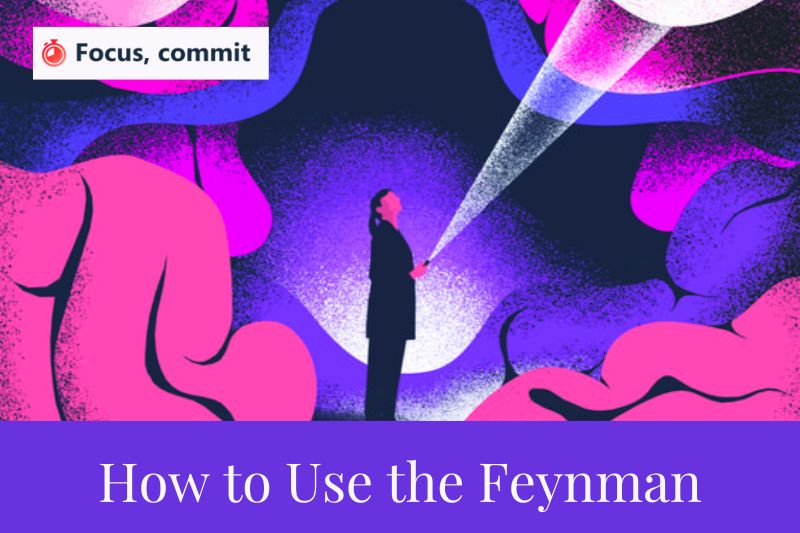In a world driven by the pursuit of knowledge and continuous learning, mastering effective learning techniques is paramount. The Feynman Technique, named after the brilliant physicist Richard Feynman, has gained popularity as a powerful method for comprehending complex subjects.
But how effective is the Feynman Technique, and can it truly help learners grasp intricate concepts faster and more efficiently? In this article, FocusCommit will explore how to learn anything using the Feynman Technique and harness the potential of this exceptional learning strategy.
Who was Richard Feynman?

Richard Feynman, whose full name is Richard Phillips Feynman, was an American theoretical physicist known for his contributions to quantum mechanics and electrodynamics. He was born on May 11, 1918, in Queens, New York City, and passed away on February 15, 1988.
Richard Feynman won the Nobel Prize in physics and was the visionary behind the Feynman diagram and positron theory, which left an indelible mark on science. In addition to his groundbreaking contributions, he was a member of the Rogers Commission and shared his profound knowledge with the public through engaging books and lectures.
Often called “the great explainer,” Feynman is celebrated as one of the outstanding science educators of our time, earning a well-deserved reputation as a truly brilliant intellectual. Feynman is considered one of the most influential physicists of the 20th century and was known for his exceptional scientific insights, teaching abilities, and charismatic personality.
What is the Feynman Technique?
The Feynman Technique, created by the renowned physicist Richard Feynman, is a highly effective learning approach. Its purpose is to assist individuals in comprehending intricate concepts, retaining information over the long term, and enhancing their capacity to articulate these ideas.
Allocating a dedicated notebook to a fresh learning endeavor can offer tailored recommendations to bolster your commitment to this challenging process. This approach is also commonly referred to as The Feynman Notebook Method, and it encompasses four fundamental steps:
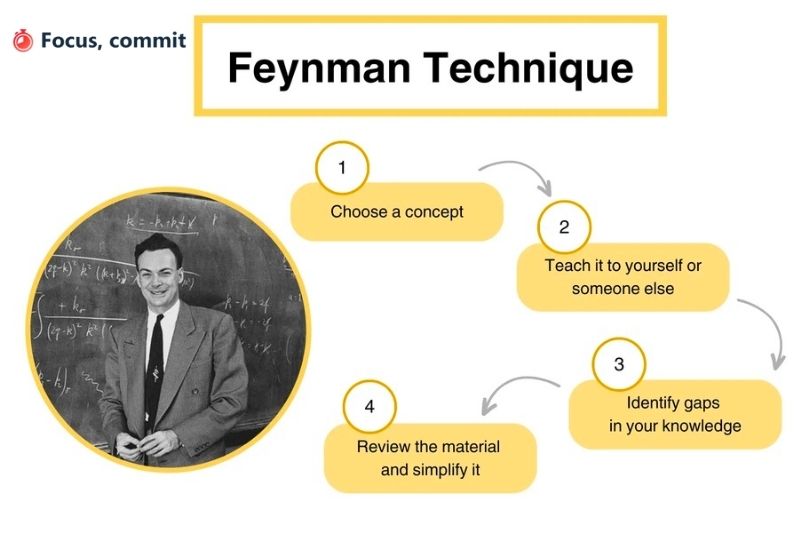
- Choose a Concept: Select the subject or concept you want to learn or understand better. It could be anything from a challenging academic issue to a practical skill or a complex idea.
- Clarify it for your understanding or teach someone else its comprehension: Pretend you’re explaining the chosen topic to a child without prior knowledge. Use simple language, avoid technical jargon, and break down the concept into its most basic components. This step forces you to grasp the concept’s fundamental ideas and principles.
- Identify Knowledge Gaps: As you explain the concept to your “student,” you may encounter areas where your understanding is lacking or unclear. These are your knowledge gaps, and they need to be addressed. Go back to your primary source material to fill in these gaps.
- Review and Simplify: Simplify your explanation further after addressing your knowledge gaps. Ensure you can explain the concept concisely and clearly to anyone, even a child. This final review helps solidify your understanding and reinforces your ability to convey the idea effectively.
The Feynman Technique is a potent approach for mastering various subjects, yet it finds its niche when dealing with expansive subjects that can be subdivided into smaller subtopics. This is primarily because these domains frequently hinge on intricate jargon and elusive abstractions. You can enhance your comprehension and recall by deconstructing these abstract notions and elucidating them in plain language.
How the Feynman Technique Works
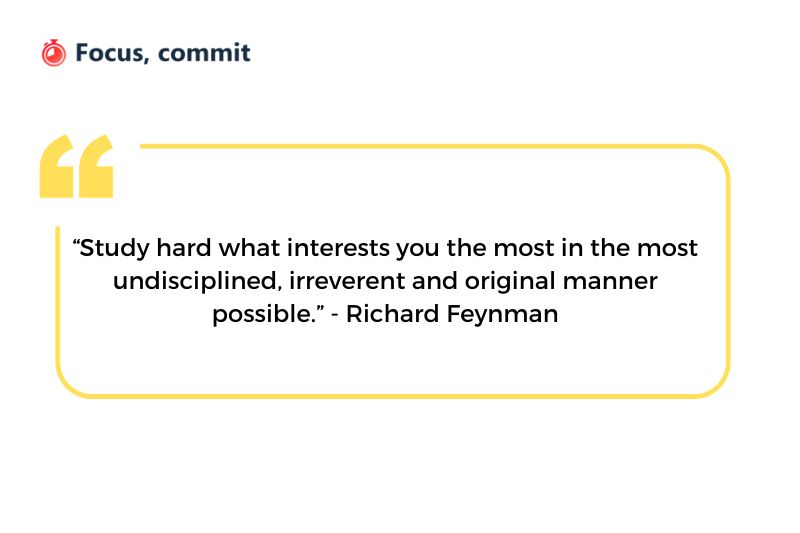
Choose a Concept
It is the initial step in the Feynman Technique, and it involves the selection of the subject or concept that you aim to learn or enhance your understanding of. This step is pivotal because it sets the stage for learning.
The key is to choose a topic that genuinely interests you or aligns with your learning objectives. It should be a subject you’re motivated to explore deeply. Your curiosity and enthusiasm for the topic will drive your commitment to learning.
Why this step is effective:
- Acknowledging Knowledge Gaps: When you jot down a topic on a blank page, you confront the extent of your ignorance. This act is a candid admission that you’re beginning from scratch or, at the very least, working to fill in some substantial gaps in your understanding. It marks the essential starting point of your learning journey.
- Specificity Matters: Considering the vast expanse of human knowledge, it becomes evident that we are profoundly ignorant about most subjects. Listing what you don’t know provides a clear and specific starting point. It narrows your focus and helps you pinpoint where to direct your learning efforts.
- Starting Small: The constraints of a single page (or a few pages) compel you to start small and remain concise. You come to realize that you can’t possibly encapsulate the entirety of vast subjects like “Evolutionary Science,” “Microeconomics,” or “Psychology” in such limited space. Consequently, you’re encouraged to break these expansive topics into more manageable, well-defined concepts. This approach is practical, as it aligns with what might be reasonably covered on a midterm or final exam, ensuring that you concentrate on the subject’s most relevant and foundational aspects.
Clarify it for your understanding or teach someone else its comprehension
This step in the Feynman trick bridges your knowledge and a deeper understanding of the chosen topic. It prompts you to deconstruct complex ideas, clarify them for yourself, and develop the skills to convey them simply and comprehensibly to others.

This step serves two primary purposes:
- Deepening Personal Understanding: When you attempt to clarify the chosen topic for your understanding, you’re actively engaging with the subject matter. You break down complex ideas into more manageable components by explaining them in simple language and avoiding technical jargon. This process necessitates a profound comprehension of the subject because you must identify and convey the fundamental principles. Essentially, you’re trying to simplify the concept to its core, which can only be achieved through a deep understanding.
- Effective Communication: The analogy of explaining the topic to a child highlights the importance of effective communication. Children often need more prior knowledge and rely on straightforward explanations. When you adopt this approach, you’re challenged to present the subject matter in a clear and easily understandable manner. This not only aids in your understanding but also prepares you to communicate the concept effectively to others. Teaching or explaining a topic is a powerful way to reinforce your knowledge.
Why this step is effective:
- Enhanced Self-Understanding: This step acts as a reality check that makes it difficult to deceive yourself. When you commit to explaining a topic, whether in writing or verbally, you’re forced to confront any gaps in your reasoning and the areas where your knowledge is lacking. This process reveals the limitations of your current understanding. Writing and teaching become tools for actively acquiring experience, not just activities you engage in once you’ve already grasped a subject.
- Accountability to Others: Explaining a concept to someone else, whether a peer, a friend, or a mentor, adds a layer of accountability. If your explanation needs clarity or coherence, your audience will likely provide feedback or display signs of transparency. As a test, you can ask them to recap what you’ve taught them in their own words. If they struggle or fail to do so, it indicates that your explanation may be overly complex or unclear. This feedback loop encourages you to simplify your cause and use plain language to ensure better comprehension.
- Confidence Building: As you gain a deep and nuanced understanding of a topic, it “clicks” in your mind. You have become adept at explaining it thoroughly, addressing exceptions, and identifying logical inconsistencies. This process builds confidence and empowers you to tackle even more challenging subjects with assurance, knowing that you’ve established a solid foundation for learning.
Identify Knowledge Gaps
While simplifying the concept for your “student,” you may stumble upon areas where your comprehension is deficient or unclear. These instances signify your knowledge gaps, and it’s imperative to resolve them. Return to your primary source material to rectify these gaps in your understanding.
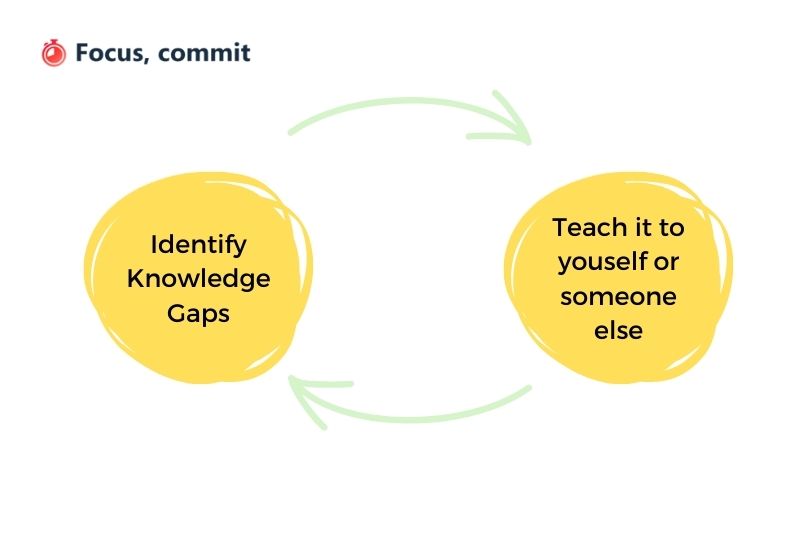
Why this step is effective:
- Embracing Continuous Learning: This step transforms learning into an ongoing and iterative process. Instead of considering learning a one-time endeavor, it encourages you to view it as a continuous journey of improvement and refinement. You’re granted permission to continually refresh and enhance your knowledge, recognizing that understanding deepens with each iteration.
- Active Engagement: Utilizing sources to refine your explanations and mental models is an active and participatory process. When you passively consume information, committing details to memory can be challenging. In contrast, when you actively create your summaries and reasoning, drawing intentionally from sources to fill gaps in your understanding, you facilitate the transfer of knowledge into your long-term memory more effectively.
- Expanding Knowledge Capacity: Paradoxically, as you accumulate knowledge, your learning capacity expands. This step highlights that the more you immerse yourself in a subject, the more understandable it becomes. Initially, a chapter from a textbook might seem like an entirely different language. Upon revisiting it, it becomes clearer. With a strong foundational understanding, subsequent encounters allow you to discern previously indistinguishable nuances.
Review and Simplify
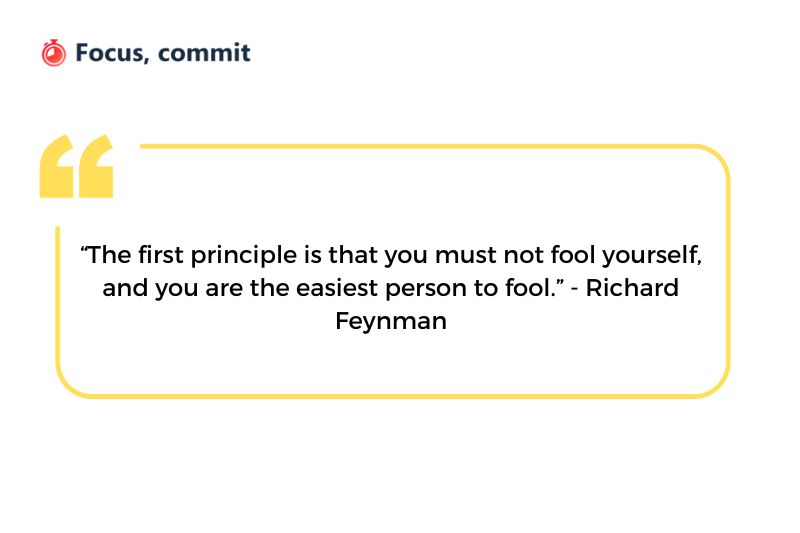
After addressing your knowledge gaps, refining and simplifying your explanation is the next crucial step. The goal is to distill the concept to its essence, ensuring it can be articulated clearly, concisely, and easily understandable. This process removes any remaining complexities, technical jargon, or unnecessary details.
Simplifying complex topics to their core components enhances your ability to communicate effectively. Whether you’re teaching, presenting, or discussing the concept professionally, the clarity you’ve achieved through this step allows you to convey ideas with precision and impact.
Why this step is effective:
- Simplicity Indicates Comprehension: The step’s effectiveness lies in the principle that simplicity is a reliable indicator of true understanding. While memorizing complex terms and reciting them when prompted is relatively easy, more is needed to signify comprehension. Real sense emerges when you distill a concept into its most basic form. By stripping away the veneer of jargon and complexity, you expose your true grasp of the subject matter.
- Enhanced Recall through Analogies: The use of analogies is another key factor in the effectiveness of this step. Metaphors serve as cognitive shortcuts, allowing you to create a mental shorthand for recalling complex concepts quickly and explaining them to others clearly. Often, educational materials provide ready-made analogies, such as the classic “the mitochondria are the powerhouse of the cell.” However, the true power lies in your ability to generate your analogies. Crafting your metaphors reinforces your understanding deeper than regurgitating borrowed ones, as it necessitates a genuine comprehension of the concept.
Example of the use of the Feynman Technique
Let’s say you want to understand the concept of “quantum entanglement” from physics by the Feynman integration trick:
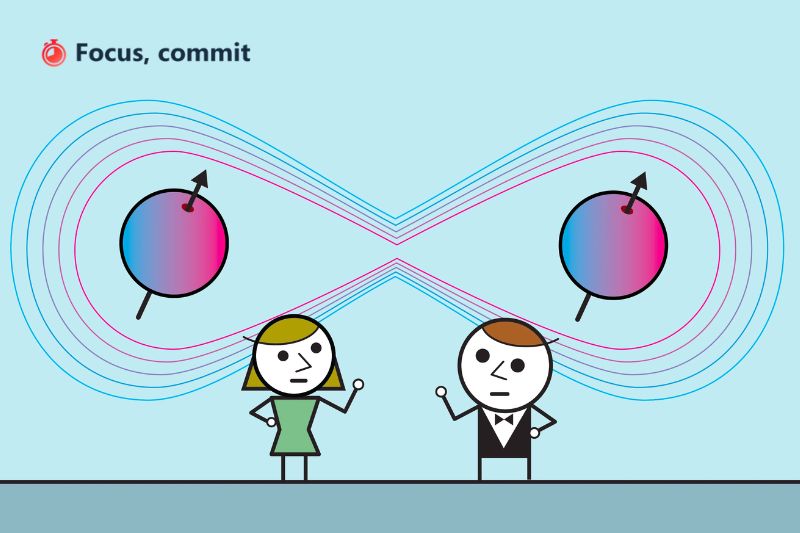
- Choose a Concept: Select “quantum entanglement” as your topic.
- Explain Simply: Begin explaining quantum entanglement in the simplest terms possible. You might say, “Imagine two particles, like two tiny marbles, that are connected specially. When one marble spins clockwise, the other always spins counterclockwise, no matter how far apart. It’s like they have a secret connection that lets them ‘talk’ to each other instantly.”
- Identify Gaps and Discrepancies: While explaining, you might realize that you’re not entirely clear on how this “secret connection” works or why it’s so important in quantum physics. These are the gaps in your understanding.
- Review and Simplify: To fill in the gaps, you consult physics textbooks, watch educational videos, and seek explanations from experts. You learn about entangled states and how mathematical equations like the Bell inequality describe them. After thorough research, you refine your answer to include these details while keeping it simple and understandable.
Pros and Cons of Using the Feynman Technique
Pros of Using the Feynman Technique

- Enhanced Understanding: The technique encourages learners to break down complex concepts into simpler terms, leading to a deeper and more comprehensive understanding of the subject matter.
- Active Engagement: It promotes active learning by requiring learners to articulate their understanding. This level of engagement enhances retention and comprehension.
- Clarity and Simplicity: By simplifying explanations and using plain language, the technique makes complex ideas more accessible, increasing the chances of successful learning.
- Self-Assessment: It enables learners to identify gaps in their knowledge and understanding, helping them recognize areas that need improvement.
- Versatility: The Feynman study Technique can be applied to various subjects and disciplines, making it a valuable tool for diverse learning needs.
- Problem-Solving: It can be particularly useful for breaking down and solving complex problems, as it encourages a systematic approach to dissecting issues.
- Effective Communication: The technique enhances communication skills by teaching individuals to convey complex ideas clearly and understandably.
- Confidence Building: As learners repeatedly explain and simplify concepts, they often gain confidence in their understanding, which can be empowering.
Cons of Using the Feynman Technique
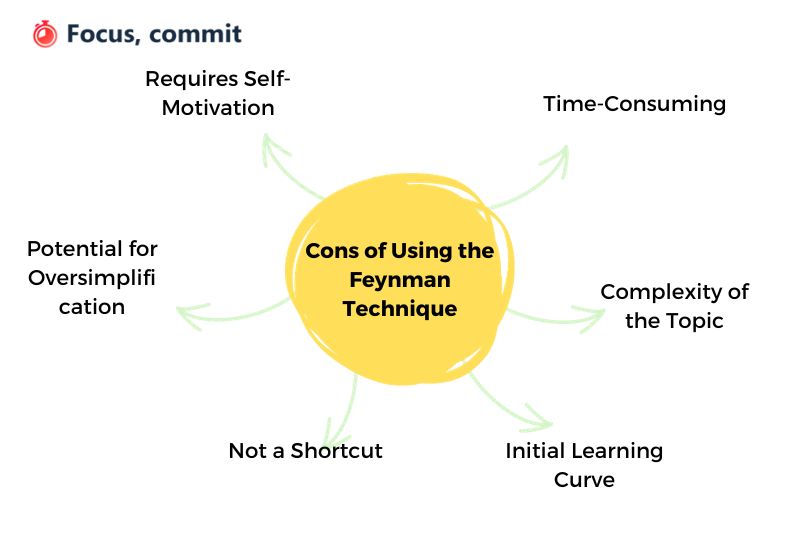
- Time-Consuming: Applying the Feynman Technique for learning can be time-consuming, as it involves multiple iterations of simplification and explanation. This may not be suitable for quick learning or cramming.
- Complexity of the Topic: While the technique is designed to simplify complex topics, extremely intricate or highly specialized subjects may still require more work to grasp fully using this method.
- Initial Learning Curve: For beginners, especially those new to the technique, there may be a learning curve for applying it effectively. It may take time to become proficient.
- Not a Shortcut: The Feynman Technique doesn’t provide shortcuts to learning. It requires effort and dedication to break down and explain concepts thoroughly.
- Potential for Oversimplification: To simplify, learners may inadvertently oversimplify complex ideas, missing nuances or essential details.
- Requires Self-Motivation: The technique relies on self-initiative and motivation. It may be less effective if a learner needs more explanation or discipline.
Final Thoughts
The Feynman Technique, emphasizing simplicity, clarity, and active engagement, has proven to be an effective tool for understanding complex concepts.
While the effectiveness of the Feynman Technique may vary depending on individual learning styles and the complexity of the subject matter, it remains a valuable asset for learners of all ages.
By implementing Feynman’s Technique, individuals can unlock the power of their minds, making pursuing knowledge more efficient and rewarding. Richard Feynman once said, “The first principle is that you must not fool yourself, and you are the easiest person to fool.”
